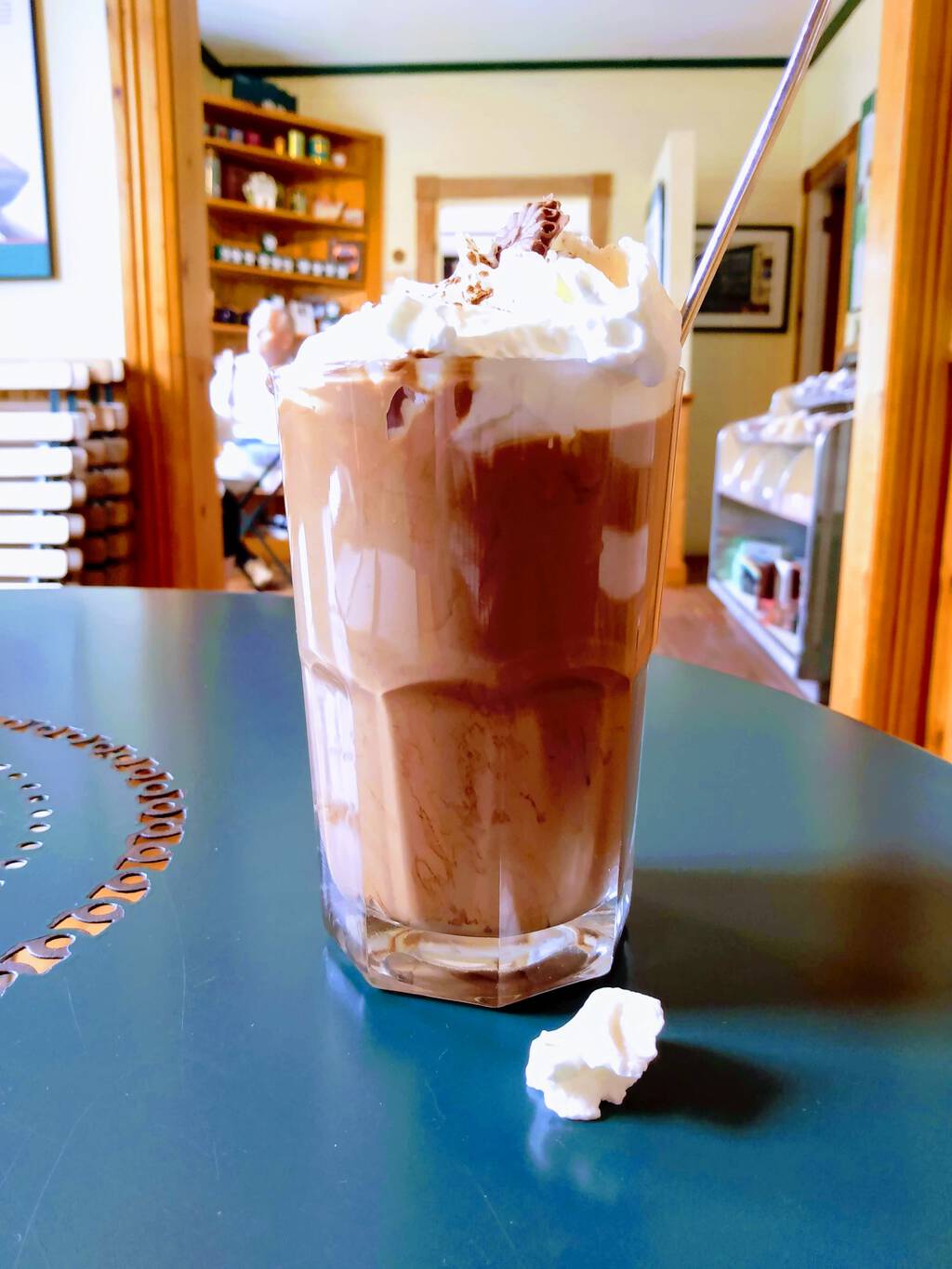If you’re at Receiver Coffee on Victoria Row this summer, and Joel is behind the bar, order up “The Joel” for a delightful iced summer drink.
Speaking of Receiver: they’re about to open a third location, out on the North River Causeway, and roasting and baking operations will be relocated out there. They’re still casting about for a name; I’m advocating for Receiver Underwater, as a tip of the hat to climate change, but it’s not garnering much support.
Caledonia House Coffee at the Charlottetown Farmers’ Market has a perpetual summer problem, as the newly-arriving hordes of irregulars clog up the coffee line. Bret is working to mitigate this issue by opening up a second coffee stand, outside in the trailer formerly occupied by 4S. The coffee’s just as good, and the line–at least for now–a lot shorter.
Speaking of the market: don’t forget that it’s now open on Wednesday–in addition to the regular Saturday–for the summer. It’s a lot less busy, but there’s still a good complement of vendors, and it’s a great place to stop for lunch.
The best thing ever to happen to the downtown Sunday flea market in Charlottetown has been to close Queen Street below Grafton: the result is that the vendors are now facing in to the street rather than out to the sidewalk, rendering the sidewalks clear and the street a pleasant place for a car-free stroll. I had a very nice rajmah chawal from The Great Indian Curry for lunch today.
If you’re a fan of the A&W Beyond Meat burger, you can now get a similar vegetarian concoction at Tim Horton Donuts, the Beyond Sausage. It appears to be popular–or at least more popular than anticipated–as I’ve encountered a couple of situations where a outlet doesn’t have any stock. And don’t let them tell you that you need to order it with egg: the Beyond Sausage Lettuce Tomato is just that; this hasn’t been internalized by all staff yet.
A reminder that, as reported earlier, Riverview Country Market now has a Downeast Soap refilling station. I’ve started to regularly buy our hand and laundry soap there and not only is it great to not be buying new plastic bottles every time, but the price is significantly less than buying a brand new bottle at Sobeys.
And, finally, my annual recommendation for The Best Thing Ever, the Factory Coffee at Island Chocolates in Victoria. It’s the one regular concession I make to avoiding sugar and it is fantastic.

Thanks to a helpful post by William Denton, I remembered the Android utility Tasker, and realized that I could use it to automate the gluing together of my Android phone and my Mac.
Here’s what I did.
First, I installed Tasker on my phone from Google Play and then the Termux:Task add-on from F-Droid.
Next, on my phone I launched Termux, created a directory ~/.termux/tasker, and created two scripts there.
The first, start-ssh, to start the SSH server on the phone (after killing it first, in case it was running already):
#!/bin/bash
pkill sshd
sshd
The second, mount-phone-on-mac, to mount the phone on the Mac (by SSHing to the Mac and doing the mount from there, unmounting it first in case it was already mounted):
#!/bin/bash
ssh peter@192.168.2.2 "umount ~/motog7"
ssh peter@192.168.2.2 "/usr/local/bin/sshfs phone:/storage/emulated/0 ~/motog7 -o volname=motog7 -p 8022"
To allow this second script to work properly, I had to do a couple of things.
First, in System Preferences on the Mac, I had to check the “Remote Login” box on the Sharing sheet.
Second, on the phone, in Termux, I had to create an SSH keypair:
ssh-keygen -t rsa -b 2048 -f id_rsa
This left me with a public key file ~/.ssh/id_rsa.pub that I then added to the end of ~/.ssh/authorized_keys on my Mac.
I made these two scripts executable with:
chmod +x ~/.termux/tasker/*
I then tested them out to make sure they worked.
Next, I set up Tasker.
I created a new Profile called Reinventorium with the trigger of State > Wifi Connected and the SSID of my office’s wireless network:

I added a new Task called Mac to this Profile, and added two Actions to that Task, one for each of the two scripts I created above, selecting Plugin > Termux:Task from the Action category and entering the name of the script:

With all of this in place, every time I come into the office with my phone and it connects to the office wireless network, it automatically launches its SSH server, and tells my Mac to mount its storage.
Following a link on Frank’s blog, I learned about an innovative mortgage product from the Dutch Triodos Bank, the sustainable mortgage:
With the Triodos Mortgage you get a discount on the interest when your house becomes more sustainable. We offer the Triodos Energy Saving Loan for the renovation. With this loan you can finance up to 25,000 euros in sustainable adjustments to your home. The great thing is that the interest on this loan is only 50% of the interest on your mortgage.
This is an excellent idea.
Back in 2012 I booked a flight to Berlin that was scheduled to land at the new Berlin Brandenburg Airport. Before I flew, however, I received a message from the airline telling me that the new airport’s opening was delayed and that I’d be landing at the venerable Berlin Tegel instead.
Remarkably, Berlin Brandenburg still has yet to open, and the reasons behind this are the subject of the four-episode podcast, How To Fuck Up An Airport, from Radio Spaetkauf:
Every Berliner knows the new airport is late. Few know exactly why. We’re here to explain. BER is the international airport code for Berlin Brandenburg Airport, nickname Willy Brandt. It has also become a signifier of failure, incompetence, corruption and Berlin’s general inability to get its act together.
If you’ve flown to Berlin Schönefeld Airport in the last few years, you’ll have seen BER as your plane taxied along the runway. But despite outward appearances, BER is far from finished. It has been under construction for 11 years, blown through six opening dates, three general managers and two state leaders. Costs have ballooned from around €1 billion to at least €5.4 billion.
Across this series, you’ll learn why the escalators are too short, why the lights are always on, and why the rooms seemed to be numbered by bingo. We’ll interview insiders and disgruntled workers, chase ghost trains running to the terminal, and go inside the unfinished airport.
Because I was raised in an era when we were willing to conceive of mobile devices as servers as much as clients, it’s always bothered me that the ability to mount an Android phone’s storage on a desktop PC or Mac disappeared when Google removed USB Mass Storage Mode from its operating system.
My phone is a powerful sensor array, it can have a Linux command line, making it a programmable mobile powerhouse. Not being able to easily transfer files to and from its storage is disabling.
But there’s a solution for this.
On the Phone
For greatest ease, assuming your version of Android supports it, assign your phone a static IP address on your wifi network; on Android Pie you’ll find this under the “Advanced” settings for your wifi connect:

Install Termux, either from Google Play or from F-Droid.
Once it’s installed, start the app, and start an SSH server with:
sshd
On the Mac
For greatest ease, add an entry in /etc/hosts for your phone like this:
192.168.2.8 phone
You can do this with:
sudo nano /etc/hosts
Next, assuming you already have Homebrew installed (look here if you need to install it):
brew cask install osxfuse
brew install sshfs
This will install SSHFS, which you’ll use on your Mac to mount the Android storage.
Once it’s installed, create a directory where you’d like to mount the phone storage, and do the mount:
mkdir motog7
sshfs phone:/storage/emulated/0 ~/motog7 -o volname=motog7 -p 8022
In that sshfs command:
- phone is the name I assigned to my Android phone’s static IP address in /etc/hosts
- /storage/emulated/0 is the Android path I want to mount on my phone
- ~/motog7 is the directory I created on my Mac for the mount
- -p 8022 sets the SSH port to use for the mount as 8022, which is what Termux uses by default
You might get a warning dialog “System Extension Blocked” when you attempt the mount; you can allow this to proceed under System Preferences > Security & Privacy.
Use your new superpowers…
Assuming all went according to plan, you now have the Android’s storage mounted on your Mac.
It will show up in the Finder:

And it will be accessible from the command line:
macmini:~ peter$ ls ~/motog7
Alarms Download Recordings bluetooth
Android Movies Ringtones osmand
BROTHER Music Signal osmdroid
Cardboard Notifications Telegram osmtracker
DCIM Pictures Vespucci
Documents Podcasts alt_autocycle
You can treat it like another disk drive.
To Unmount
To umount the phone:
umount ~/motog7
You may find that the mount kills itself if the Termux app on your phone is terminated by Android.
Me: Oliver, do you have your Spotify playlist ready for tonight?
Oliver: No. I’m watching Beto O’Rourke.
Me: Okay.
This is a post about gluing some things together, and about the IndieWeb. It started, however, with a photo of a child on a bicycle.
I liked that photo, and I wanted to express that somehow in a public fashion.
I didn’t want to leave a comment on that blog post, as my aspirations were simply to express admiration for the photo and its subject; I was looking for something more “hej!”
It turns out that there’s IndieWeb for that.
One way of thinking about the IndieWeb is “all the plumbing of corporate social networks, without any of the corporate social networks required.”
In other words, in this case, “a like button for the web.”
Another way of thinking about the IndieWeb is to focus on the Indie: it’s a decentralized jam that allows us all to bring our own tools to the table, but to interoperate.
In my case the tools I needed to glue together are FreshRSS (the RSS feedreader where that bicycle photo originally caught my eye) and Drupal, which I use to write this blog.
Click the Star in FreshRSS
The way I decided to make this all work is to wire up “favouriting” a post in FreshRSS to sending a Webmention.
So I do this:
and I cause this to happen:

Pull The Favourites
My original approach was to try to code up a FreshRSS extension that would make this all happen in real time; I quickly decided that I didn’t want to have to grok a new MVC framework to make this happen, and that real time liking didn’t really need to happen.
I decided, instead, to simply extract favourites from FreshRSS on a regular schedule and to create new Drupal posts for new ones I encounter.
FreshRSS’s “entry” table makes this easy, as there’s a boolean field for each entry called is_favorite:

I only want to create a post in Drupal once, so I created an additional table, favourites_rss, to track those I’ve already processed. The result is that I can extract the details of new favourites by this bit of SQL:
SELECT en.id,title,link,date,website,name
from freshrss_peter_entry en,freshrss_peter_feed
where
(freshrss_peter_feed.id = en.id_feed) and
(is_favorite = 1) and
en.id not in (select fav.id from favourites_rss fav)
This returns me all the information I need about each favourite:
- The title of the post
- The link to the post
- The date of the post
- The title of the blog where the post lives
- The link to the blog
Post the Favourites
I created a new Drupal content type called Favourite with fields for each of these pieces of information:

With that in place I can programmatically add new favourites in Drupal like this, in PHP:
foreach($favs as $key => $row) {
$node = new stdClass();
$node->type = $nodetype;
node_object_prepare($node);
$node->language = 'und';
$node->title = html_entity_decode($row['title']);
$node->uid = 1;
$node->status = 1; //(1 or 0): published or not
$node->promote = 0; //(1 or 0): promoted to front page
$node->comment = 0; // 0 = comments disabled, 1 = read only, 2 = read/write
$node->field_feed_title[$node->language][0]['value'] = html_entity_decode($row['name']);
$node->field_website[$node->language][0]['url'] = $row['website'];
$node->field_website[$node->language][0]['title'] = html_entity_decode($row['name']);
$node->field_link[$node->language][0]['url'] = $row['link'];
$node->field_link[$node->language][0]['title'] = html_entity_decode($row['title']);
if($node = node_submit($node)) { // Prepare node for saving
$node->created = $row['date'];
node_save($node);
webmention_send($node->nid);
}
}
The post that got created for the bicycle photo is here; if you look at the HTML of that post, you’ll see that the link includes the CSS class u-like-of:
<a href="http://infullflow.net/2019/06/naar-het-park/" class="u-like-of">Naar het park</a>
The call to webmention_send() is the secret sauce that sends a Webmention to the original favourites post, a Webmention that signals “I like you” because of that CSS class.
Release the Favourites!
With all my favourites now safely tucked away in Drupal posts, with Webmentions sent to their hosts, I can also expose everything I’ve favourited to all-comers.
Drupal makes this easy using Views, which I used to create this Favourites page, that lists them all, in reverse chronological order; I also used Views to create an RSS feed of my favourites that you can plug into your RSS reader, should you like (and to allow the river of love to overflow its banks ever further).
Although it took some fiddling to make all this happens, now that the fiddling is fiddled, it just works: I click the star in FreshRSS and the favourite appears on this list, in this RSS feed, and, should the blog I favourited the link from support Webmentions, as a “like” on the original post.
The Plastic Bag Reduction Act comes into force here on PEI next week.
My favourite part of the legislation—other than the “no more plastic bags” part—is that there’s an exemption to allow plastic bags to “transport live fish.”
“Hold on, Marv, what about goldfish?!”, one can imagine the engaged public servant exclaiming during the drafting of the bill.
Which causes me to recall a song I wrote for Catherine during our early courting:
I don’t like your fish, I don’t like them very much.
I don’t like the way they look at me, and talk about such and such (and such and such).
I don’t like your fish, I don’t like them one bit.
I don’t like the way they swim around, and I don’t like the way they shit (all over the place).
Chorus:
But I sure (sure) do like you. Yes I do.
Not the best wooing song, perhaps. But it worked.
I met this morning with Shayne Connolly, my personable life insurance broker. While reviewing our coverage he scrolled by the section of the PDF that had my actuarial age at death as 84.
It wasn’t so much that this was news to me as how casually it floated by.
According to the US Social Security actuarial tables, my probability of dying in the next year is 0.65%. By the time I’m 84 it goes up to 8%. If I live to 119, I’ll have an 88% probability of being dead with a year.
In this, as in all things statistical, the words of the late Stephen Jay Gould in The Median Isn’t the Message are helpful:
We still carry the historical baggage of a Platonic heritage that seeks sharp essences and definite boundaries. (Thus we hope to find an unambiguous “beginning of life” or “definition of death,” although nature often comes to us as irreducible continua.) This Platonic heritage, with its emphasis in clear distinctions and separated immutable entities, leads us to view statistical measures of central tendency wrongly, indeed opposite to the appropriate interpretation in our actual world of variation, shadings, and continua. In short, we view means and medians as the hard “realities,” and the variation that permits their calculation as a set of transient and imperfect measurements of this hidden essence. If the median is the reality and variation around the median just a device for its calculation, the “I will probably be dead in eight months” may pass as a reasonable interpretation.
Some encouraging discussion about cycling during Question Period in the Legislative Assembly yesterday, prompted by a question from Steve Howard, Green Party Shadow Critic for Transportation, Infrastructure, and Energy:
Mr. Howard: Thank you, Mr. Speaker. Electric bikes are another emerging trend. These can be used to get around outside of winter months. This combination of active transportation and small scale electrification will become more prevalent. Are there any plans to encourage the uptake of electric bikes?
Speaker: The hon. Minister of Transportation, Infrastructure and Energy.
Mr. Myers: Thank you, Mr. Speaker. At this point we haven’t even gotten a program off the ground to help people get into electric cars, so we’re working towards that. As we talked about in House here last week, I believe our solar option is stage one to living a sustainable lifestyle and as I’ve said to you in private discussions, I believe that electric vehicles is clearly stage two – something that I’m committed to work towards, it’s something that our government is committed to work towards and I’ll take any recommendations you have seriously and I’ll bring them back to our efficiency people and to our energy people and make sure that they get on the agenda.
Speaker: The hon. Member from Summerside-South Drive.
Mr. Howard: Thank you, Mr. Speaker. The active transportation network’s bike lanes and regulations will be sufficient to encourage the safe use of these of these types of active transportation. The range extension that electric assist affords means it would become much easier to bike into town from rural areas – meaning we will see an uptake in bicycles on our highways. Can we expect to see any improvements to highway planning infrastructure that will accommodate the inclusion of more bicycle traffic?
Speaker: The hon. Minister of Transportation, Infrastructure and Energy.
Mr. Myers: Thank you, Mr. Speaker. So we have a sustainable transportation committee – the Minister of Environment, Water and Climate Change; him and I set that up not that long ago. We have a strategy that we’re about to unveil that’s going to cover a number of topics, one of them will be active transportation links and how we plan to deal with them moving forward in the future, so yes, it’s on our agenda. I realize there hasn’t been a lot done in the province in the last 100 years as far as bicycle goes. Prior to that probably there was. At this point, since there are some vehicles on the road there’s been very little done to accommodate any other type of vehicle on the road. Yes, it’s something that we’re looking at. It’s something that’s in our planning, and it’s something that we’re going to try to get to as we build new highway structures across Prince Edward Island.
I’m happy both that the question was asked, and also the spirit of the reply.
 I am
I am